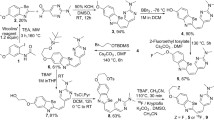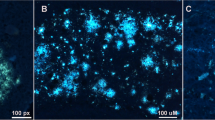Abstract
Development of probes for β-amyloid (Aβ) plaques, a critical factor associated with Alzheimer’s disease (AD), provides important tools for studying their role in AD. Previously, we reported [125I]IMSB and [125I]ISB as excellent probes for Aβ plaque labeling. Despite their exquisite in vitro binding characteristics, low brain uptakes (likely due to two ionizable carboxylic acid groups) limited their potential as in vivo imaging agents. To improve brain penetration, we have successfully prepared a neutral radioiodinated probe [125I]3. The improved probe displayed good binding affinity for Aβ aggregates (Ki=2.0 ± 0.2 using Aβ40 aggregates). In addition, the brominated counterpart displayed fluorescent-staining properties of Aβ plaques in postmortem AD brain sections similar to BSB, a fluoroscent probe reported previously. [125I]3 gave excellent plaque labeling by film autoradiography of AD brain sections. Unlike [125I]IMSB (which preferentially detects Aβ40 plaques), the improved radioioinated probe, [125I]3, can readily detect plaques containing aggregates of both Aβ40 and Aβ42. The initial brain uptake of [125I]3 in normal mice at 2 min p.i. was moderate (0.18% ID) and displayed a very slow washout from the brain (0.11 %.ID at 4 h p.i). Taken together, these data suggest that [125I]3 is useful for in vitro plaque detection, it may not be suitable for in vivo monitoring of Aβ progression and deposition.
Similar content being viewed by others
References
Agdeppa E. D., Kepe V., Liu J., et al. (2001) In vitro and in vivo binding characteristics of two biological probes for plaques and tangle in Alzheimer’s Disease. J. Labelled Compounds Radiopharmaceut. 44(Suppl. 1), S242-S244.
Dezutter N. A., Dom R. J., de Groot T. J., et al. (1999) 99mTc-MAMA-chrysamine G, a probe for beta-amyloid protein of Alzheimer’s disease. Euro. J. Nuclear Med. 26(11), 1392–1399.
Hardy J. A. and Higgins G. A. (1992) Alzheimer’s disease: the amyloid cascade hypothesis. Science 256, 184–185.
Jarrett J. T., Berger E. P., and Lansbury P. T. Jr. (1993) The carboxy terminus of the beta amyloid protein is critical for the seeding of amyloid formation: implications for the pathogenesis of Alzheimer’s disease. Biochemistry 32(18), 4693–4697.
Klunk W. E., Debnath M. L., and Pettegrew J. W. (1995) Chrysamine-G binding to Alzheimer’s and control brain: autopsy study of a new amyloid probe. Neurobiol. Aging 16(4), 541–548.
Kurihara A. and Pardridge W. M. (2000) Abeta(1–40) peptide radiopharmaceuticals for brain amyloid imaging: [111In] chelation, conjugation to poly(ethylene glycol)-biotin linkers, and autoradiography with Alzheimer’s disease brain sections. Bioconjug. Chem. 11(3), 380–386.
Lippa C. F., Nee L. E., Mori H., et al. (1998) Ab-42 deposition precedes other changes in PS-1 alzheimer’s disease. Lancet 352, 1117–1118.
Mathis C. A., Holt D. P., Wang Y., et al. (2001) Lipophilic 11C-labelled thioflavin-T analogues for imaging amyloid plaques in Alzheimer’s Disease. J. Labelled Compounds and Radiopharmaceut. 44(Suppl 1), S26-S28.
Schmidt M. L., et al. (2001) The fluorescent Congo Red derivative, (Trans, Trans)-1-Bromo-2,5-Bis-(3-Hydroxy-carbony-4-Hydroxy)Styrylbenzene (BSB), labels diverse β-pleated sheet structures in postmortem human neurodegenerative disease brains. Am. J. Pathol. 159(3), 937–943.
Selkoe D. J. (2000) Imaging Alzheimer’s amyloid. Nature Biotechnol. 18, 823–824.
Skovronsky D., Zhang B., Kung M. P., et al. (2000) In vivo detection of amyloid plaques in a mouse model of Alzheimer’s disease. Proc. Natl. Acad. Sci. USA 97(13), 7609–7614.
Wengenack T. M., Curran G. L., and Poduslo J. F. (2000) Targeting Alzheimer’s amyloid plaques in vivo. Nature Biotechnol. 18, 868–872.
Zhen W., Han H., Anguiano M., et al. (1999) Synthesis and amyloid binding properties of rhenium complexes: preliminary progress toward a reagent for SPECT imaging of Alzheimer’s disease brain. J. Med. Chem. 42(15), 2805–2815.
Zhuang Z.-P., Kung M. P., Hou C., et al. (2001) Radioiodinated styrylbenzenes and thioflavins as probes for amyloid aggregates. J. Med. Chem. 44(12), 1905–1914.
Author information
Authors and Affiliations
Corresponding author
Rights and permissions
About this article
Cite this article
Kung, MP., Hou, C., Zhuang, ZP. et al. Radioiodinated styrylbenzene derivatives as potential SPECT imaging agents for amyloid plaque detection in alzheimer’s disease. J Mol Neurosci 19, 7–10 (2002). https://doi.org/10.1007/s12031-002-0003-9
Received:
Accepted:
Issue Date:
DOI: https://doi.org/10.1007/s12031-002-0003-9




